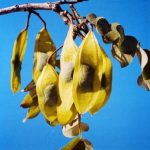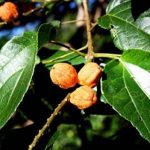TREE LIFE
June 1984
HARARE CALENDAR
Saturday June 2nd : Botanic Garden Walk. Meet in the Car Park at 1045 for 1100 hours.
Sunday June 17th : A visit to Makomorara, the home of Bruce and Margaret Underwood, Ruwa. I never fail to be amazed at the variety of species of indigenous trees which one can find within a short distance of Harare, and this venue proves it once again. From a closed canopy woodland comprising largely Parinari, one moves into open woodland, vlei and then also low kopjes. We were intrigued to see a spreading Bequaertiodendron far from any river in a vlei area atop an anthill. A pair of spotted eagle owls was flushed out as we approached.
As we again received a prohibitive quote for bus hire we have decided to share lifts and go by car. So we appeal to all who can offer lifts and all who require lifts to meet at the Monomatapa Car Park at 0900 hours. A security guard will be hired to look after vehicles left behind and we will aim to meet at Makomorara at 0945 at the latest.
DITCHWE LEMON FOREST
In this month’s Botanic Garden walk we revised the tree species we were to see at Dichwe Lemon Forest. Thanks Tom, we will include the notes within the write up. The society has visited Dichwe before and excellent notes have already been recorded by Gill Masterson and Jack Reid, Newsletter September 1972, as well as Dick Petheram, Newsletter June 1977. Jeremy Talbot’s two articles in “The Honeyguide” No. 88 and 89 are also well worth reading. On a personal note we would like to thank Trevor Gordon for being an excellent tutor, Meg for providing free field cards with Dichwe trees all laid out neatly, David Rockingham Gill of Umboe Rural Council for aiding arrangements and being at the forest to greet us, John Brown who owns the land as well as the many members of the Ayrshire Branch that came along by car.
Mashonaland is well endowed with open woodland but it is not often that we are able to experience that inner jubilation associated with a well shaded gallery forest consisting of enormous limbs planted firmly in the earth and groined over by delicate foliage. Even the tree society is dwarfed by these forest giants of Dichwe and some of us either grope for bark characteristics or divert attention to the undergrowth and forest edge. The throwing string and even binoculars have such limited value we rely entirely on the identification by other people. An attempt to recreate the sensuous awareness which this forest invokes within the nervous system is pointless. It is safer to list the parts that contribute to the whole; these include Khaya nyasica, Trichilia emetica, Acacia galpinii, Albizia zimmermannii, Celtis africana, Rauvolfia caffra, Ekebergia capensis, a sprinkling of lemon trees probably introduced by the Arabs/Portuguese, an extensive water supply and great age. As I find these trees truly awful, in the original sense of the work, and have not yet had sufficient contact with these Goliaths to face them squarely, I will discuss the two other areas we examined; firstly, a limestone kopje southeast of Dichwe and the woodland along the forest edge immediately southeast of the swamp forest.
The morning climb in the limestone hills proved most rewarding. No less than six species of peeling bark trees grew alongside each other, an excellent example of convergence where a similar morphology is developed in totally unrelated species growing under the same kind of conditions.
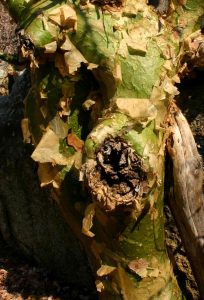
Commiphora marlothii peeling bark. Photo: Bart Wursten. Source: Flora of Zimbabwe
In the MIMOSACEAE the Albizia tanganyicensis has thin pink peels that expose the pale cream under bark. Trevor pointed out that these peels are translucent and transmit the sunlight in contrast to the papery peels of the STERCULIACEAE which are opaque. In the large leaved Sterculia, S. quinqueloba these flakes are orange red revealing a greener under bark. A. africana is distinct as the trunk is a liver colour which comes away to display large patches of yellow. The peeling Commiphora marlothii is a member of the BURSERACEAE with large yellow peels and a green under bark, and to complete the complement for the morning we also found C. africana with small yellow peels that expose the green trunk. Fortunately the fruits aided identification of most of these trees. We are used to linking thick or corky bark with a fire controlled savanna environment in contrast to wet forest trees which often have smooth trunks. The peeling trunk so characteristic of rocky kopjes, thinking of the Matopos, must be functionally important.
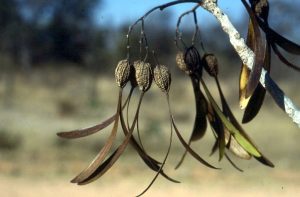
Gyrocarpus americanus, propeller pods. Photo: Meg Coates Palgrave. Source: Flora of Zimbabwe
Anyone who knows or can think of a possible advantage of this feature, I would be most interested to hear it.
With the approach of winter, the lack of leaves always forces us to notice the bark and trunk. Kirkia acuminata was leafless, although the fruits were an important clue. Its silver grey bark resembled that of Gyrocarpus americanus, the only indigenous member of the family HERNANDIACEAE. We did find a number of bright green Gyrocarpus seeds with the two wings that give it the common name of propeller tree. Albizia zimmermannii is a tree we seldom see. The longitudinal striations on the bark are reminiscent of the trunk of a fast growing Persian lilac, Melia azedarach. Many were leafless but these in full leaf displayed a fresh green colour unusual for this time of the year. A. zimmermannii resembles A. schimperiana but their distributions do not overlap. The latter species is restricted to the Eastern forests. In the vein of each leaflet divides the oval blade symmetrically, this contrast with the leaflets of both A. schimperiana and A. gummifera. I don’t remember ever having seen such a large tree like specimens of Maerua triphylla, this is a member of the CARPARACEAE. The collected specimen seems to have been lost but looking at distributions and fruit size, this may in fact have been M. prittwitzii. I regret I failed to examine the developing fruit closely.
After lunch in Dichwe we wandered around the lemon forest where we found Croton megalabotrys with the typical Croton glands at the top of the petiole. Many large specimens were multi trunked with smooth orange bark. Many of the sausage trees, Kigelia africana hung with enormous ripening fruit. We almost overlooked a scrappy specimen of the other BIGNONIACEAE, Markhamii accuminata.
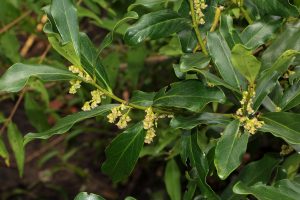
Euclea racemosa, ex E.schimperi, Photo: Bart Wursten. Source: Flora of Zimbabwe
We were treated to some new EBENACEAE species. Euclea racemosa, ex E. schimperi, is similar to the common E. divinorum except the leaves of E. racemosa are widest above the middle and taper unequally to the apex and base. The shiny green leaves are leathery and sub-opposite on the stem. Also in the EBENACEAE we saw Diospyros kirkii, Diospyros lycioides and D. mespiliformis but the real treat was D. senensis. This specimen Tom showed us in the Botanic Gardens had leaves of unequal size arranged on lateral spurs. The fruit of D. senensis showed the characteristic Diospyros persistent calyx although in this species it surrounds part of the oval fruit which therefore resembles an acorn.
In the MORACEAE we saw Ficus sur with scalloped edges to the leaves, F. ingens with a heart shaped base, F. salicifolia and after discussion as to whether each of the specimens was not the illusive F. sansibarica we suddenly noticed above the canopy a number of heavily olden branches with large figs held tightly against the old branches. The trunk, which is darkened by numerous lenticels, had the look of a strangler although it did not appear to have originated as a real strangler fig.
The forest is overgrown by Pterolobium stellatum and Acacia schweinfurthii, two thorny creepers which would have been difficult to tell apart had they not been in fruit. Trevor tells us that the Acacia has a more rigorous thorn structure at each node, with three re-curved thorns. Apparently there was a lengthy discussion on an understory Acacia in the forest, the herbarium identification discounted the A. polyacantha theory in favour of A. goetzii.
On the trip home we stopped to pick the bright orange flowers of Vernonia aurantiaca, a large scrambling shrub that added such colour to the woodland alongside the Umboe road. In closing I would like to congratulate Cheryl on her kopje climbing abilities only 40 hours before producing the tree society’s current “youngest member” Jemima Haxen, and Phil who has neglected this month’s newsletter to become chief midhusband and nappy washer.
-Kim ST.J. Damstra
MATABELELAND FUTURE PROGRAMME
Sunday, June 3rd : The Aloe, Cactus and Succulent Society has invited us to join them on a tree scramble at Mabukuweni. After the scramble we are invited to a braai lunch on the terrace for which we are asked to pay $2.50. If you wish to attend the lunch please phone Norma Hughes, 48819, between 6 and 7, any day before May 28th. Meet at Mabukuweni at 1030 hours.
For our July outing we shall visit the Matopos, making Ficus our special study, and looking at other trees on the side.
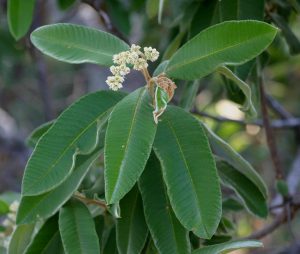
Ozoroa reticulata. Photo: Bart Wursten. Source: Flora of Zimbabwe
MAY OUTING : On Sunday May 6th we visited the north side of Upper Hillside Dam, or what used to be the dam, for it is now almost dry. Our speakers for the day were Muriel Walker Azanza garckeana and Flacourtia indica and Betty Blake, Schrebera alata and Ozoroa reticulata. Both had done some research and gave us many points to ponder. Muriel told us how variable is Flacourtia, almost anything goes! Betty had an unusually tall specimen of Ozoroa to talk about, bt it showed signs of de-barking, some of the cuts being quite fresh. A great deal of de-barking is going on in the Dams area; we are told of lorries arriving at night and taking away sacks full of bark. Policing is extremely difficult, and one despairs. Geoff Archer has a last sorted out the confusion between Tapiphyllum velutinum and Vangueriopsis lanciflora to his satisfaction; he had specimens of both to show us. To mention other trees seen on the walk, Negrosea andorigensis, Terminalia trichopoda and two cussonias conveniently close together for comparison, C. arborea and C. natalensis. Kirkia acuminata is assuming it glorious autumn yellow!
ROOT NOTE : The idea that flowers without petals are simpler than flowers with petals led to the arrangement of plants by Engler and Pantl which we still utilize today. Modern classification schemes recognize that these families, like the figs, MORACEAE, have in fact specialized flowers and belong later on in the arrangement. There is an excellent by the famous nineteenth century German botanist, Alexander Brown, especially in view of the adverse criticism flung at the great twentieth century artists like Miro and Picasso : “In nature as in art, the simplest may be the most perfected”.
Kim ST.J. Damstra
ROOT NOTE : Swynnerton’s name is often mentioned as a botanical collector in this country. Some aspects of his interesting life and character are contained in an article on Chirinda Forest by B. Goldsmith in the Zimbabwe Rhodesia Science News of March 1980 from which the following is lifted:
“A talk associated with Chirinda must include mention of Charles Francis Massy Swynnerton Rhodesia’s greatest naturalist, who in his early twenties took up residence at Gungunyana farm, which has a part of Chirinda on it. He was born and educated in Britain but spent a short time with his clergyman father in India. He worked here for Sir Guy Marshall in the early quarter of the 1900’s. Marshall became a world renowned entomologist, particularly in the study of weevils. Swynnerton, a redhead, untrained but fired with the spark of curiosity, devoted himself to scientific study of the world about him. What better place than Chirinda?
This man collected fauna and flora assiduously under the most difficult conditions. Many plants, insects and animals bear his name. Swynnertonia cardinea is a slender tall Asclepiadaceous twiner collected only twice in 70 years. Chirindia swynnertoni is a tiny pink worm like burrowing reptile removed by Swynnerton from a Kingfisher’s stomach. What a musical name for this little creature. It has only recently been re-collected in Mozambique. He walked to Beira and back at the beginning of the century, ostensibly on a tsetse fly survey. He was to become a world authority on tsetse fly and was the first Director of the East African Department of Tsetse Reclamation and Research. In 1938 he was awarded the C.M.G. for his work, but was tragically killed in a plane accident while on his way to Dar-es-Salaam with botanist companion B.D. Burtt, to receive the honour from the Governor. Glossina swynnertonii is a tsetse fly of East Africa.
Swynnerton’s botanical trips into the Chimanimani are all too briefly described. This range, and Chirinda, must have seemed like an earthly paradise, despite the discomforts, so new were the many plants he collected. Some years back I met an African, Kositina, who was one of his six porters on the Beira trip. About 80 years old, he laughed when he recalled how they quickly ran out of food, and relied on friendly chiefs to help them.
I was privileged to meet Professor Phillips of “Oxbow” Tugela river fame. This ecologist was Swynnerton’s second in command at the time of his death. He had the unenviable task of finding the remains of the crash victims in thick bush. The Professor told me that Swynnerton was a poor administrator, so much so that his enforced resignation was only prevented at the eleventh hour by the Governor of the day, a wise man, who could see greatness in another who was a fellow of the Linnean Society. Swynnerton told the professor that had he not married he could have devoted an even greater percentage of his time to his work. His wife must have been a lonely woman, but such was her lot in choosing a partner so unquestionably dedicated to his task.
Swynnerton’s homestead is a delightful spot, situated on the northern edge of the forest. Here one can see many exotic and indigenous species which he planted, and his plantation of two species of coffee. Three Camellia bushes flower profusely, with enormous pure white blooms, more showy than the nearby red ones. At the Zona river, the Scientific Association has erected a sandstone bench to commemorate Swynnerton. In this place is a profusion of two foot high Perennial Thunbergia swynnertonii which bear pretty white or blue mauve flowers.
-PHIL HAXEN, CHAIRMAN


